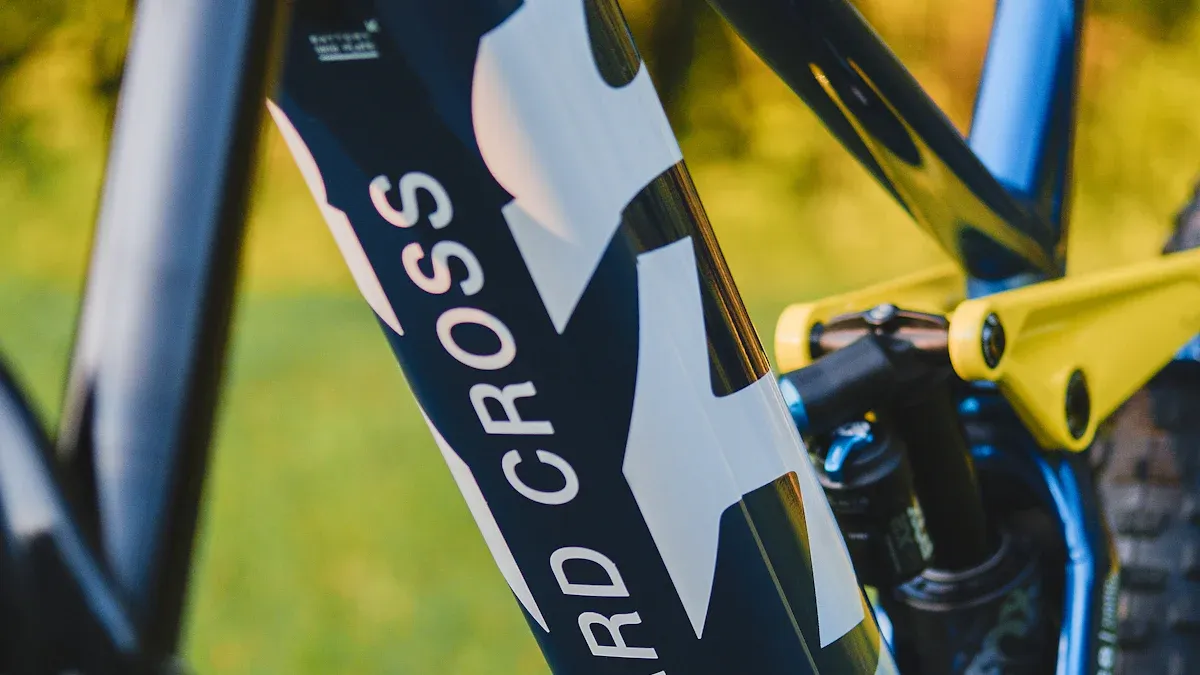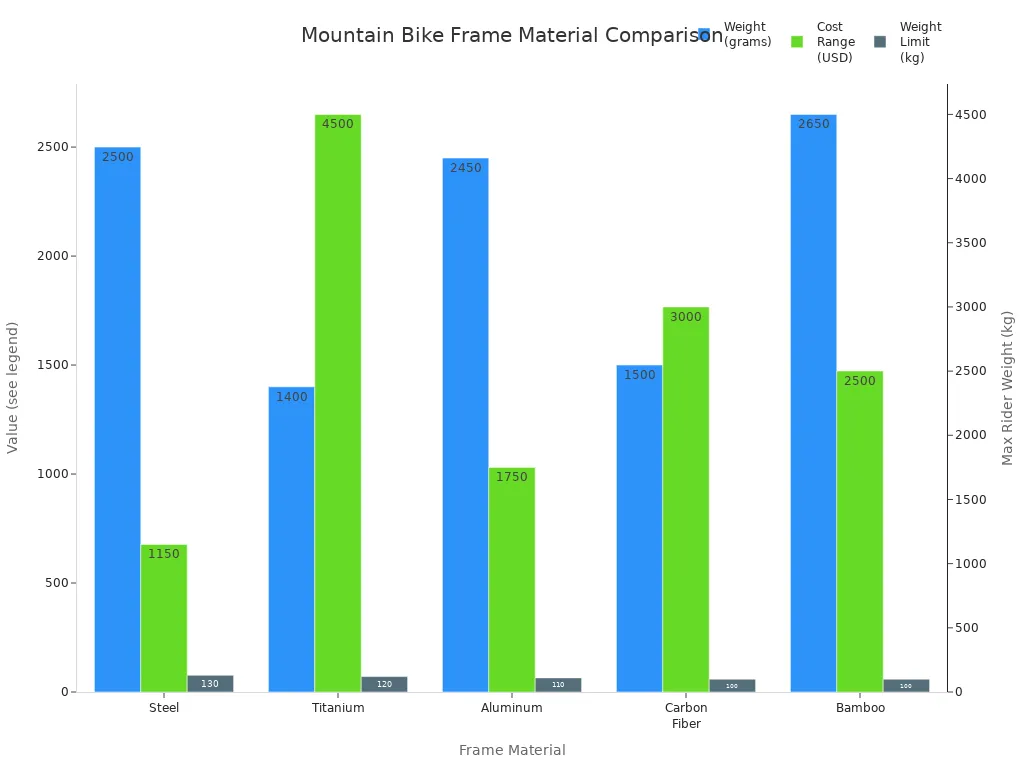
You might see that a steel mountain bike frame is good for rough or long trails. The frame you pick depends on how and where you ride. It also depends on how much work you want to do on your bike. Many people choose chromoly steel because it is strong and comfortable. Some pick hi-tensile steel because it costs less, which is good for new riders. Chromoly steel mountain bike frames help take in bumps and make you less tired on hard trails. If you crash a lot or want easy fixes, a steel mountain bike frame can help you keep riding.
Chromoly steel mountain bike frames are good for rough trails and long rides.
Hi-tensile steel frames are strong and cost less for new riders.
Steel mountain bike frames help soften bumps and are hard to break.
Key Takeaways
Steel mountain bike frames are very strong and last a long time. They bend instead of breaking, which helps keep you safe on rough trails. Steel frames give a smooth ride because they soak up bumps. This makes long rides easier for your body. Steel frames cost less than aluminum, carbon fiber, or titanium. They are also easier to fix, so you save money on repairs. Steel frames are heavier than other materials. This can make climbing hills harder. But they help you stay steady and in control when going down rough trails. To keep your steel frame nice, stop rust by keeping it clean and dry. Check the paint often to make sure it is not damaged.
Steel Mountain Bike Frame Pros

Durability
Steel mountain bike frames are very tough. They can handle rough trails and hard hits. Many people use the same steel frame for many years. Some riders still use their steel frames after 25 years. Steel bends instead of breaking. It springs back to shape. This makes steel frames last a long time. You can trust your bike to survive crashes and heavy riding.
Steel frames last longer than aluminum and carbon fiber frames. You do not have to worry about them breaking from bending too much. If you check your frame often, it will stay safe and strong.
Here is a quick chart to show how long different frame materials last:
Frame Material | Lifespan Insights | Key Points |
|---|---|---|
Steel | Can last for decades; some are still used after 25 years | Very tough, bends and springs back; good for hard use |
Aluminum | Some last 6–17 years with heavy riding | Does not break often; gets weak if bent too much |
Carbon Fiber | Needs careful care; not as much data | Lasts if you take care of it; breaks easier if hit |
Comfort
Steel frames give you a smooth ride. You feel fewer bumps and less shaking. Chromoly steel soaks up shocks well. Your hands and arms do not get as tired. Many riders say steel bikes feel lively and bouncy. This is because steel tubes can flex and move side to side.
Tests show steel frames stop side-to-side shaking better than aluminum. You notice this when you ride on rough trails. How comfy your ride feels depends on the frame’s shape and tube size. Steel frames often use thin tubes. This makes the ride softer and more flexible.
Tip: Comfort is not only about the material. The way the frame is made matters too. Pick steel if you want a softer ride, especially on long trails.
Affordability
Steel mountain bike frames are a good deal. They cost less than titanium or carbon fiber. Chromoly steel costs more than hi-tensile steel, but both are cheaper than fancy materials. You get a strong frame without spending too much.
Steel frames are cheaper to buy and fix.
You save money because steel is easy to repair.
Many beginner and mid-level bikes use steel to keep prices low.
Repairability
Steel frames are easy to fix. If your frame gets damaged, most bike shops can repair it. Steel repairs use simple tools and methods. You can even use a forge for hard fixes. Steel is the easiest frame material to repair.
Aluminum frames are hard to fix and often need to be replaced.
Carbon fiber can be fixed but needs special skills.
Steel frames are tough and last a long time. You can ride for years and fix problems without spending a lot.
Stability
Steel frames help you stay steady on the trail. The weight and strength of steel keep you in control. You feel safe riding downhill or over rocks. Many people like the classic look of steel bikes.
Many riders pick steel for its steady and solid ride. Your bike stays stable, even on rough trails.
Here is a chart that compares strength and ride feel for different frame materials:
Material | Weight & Durability | Ride Quality & Other Notes | |
|---|---|---|---|
Chromoly Steel | Stronger than high-tensile steel; can use thinner tubes | Heavier than aluminum but lighter than high-tensile steel; very tough | Soaks up bumps well; comfy and lively ride; easy to fix |
Aluminum | Lighter and stiffer but not as tough as chromoly steel | Lightest metal but can get dents and weak spots | Feels rougher; does not soak up bumps as well |
Carbon Fiber | Lightest and stiffest; strong but breaks easier if hit | Very light but can break if dropped | Good for racing; not as tough against hits |
Titanium | As strong or stronger than chromoly steel | Light and does not rust | Feels great to ride; does not rust but costs more |
Steel Mountain Bike Frame Cons
Weight
You notice the weight of a steel mountain bike frame as soon as you pick up your bike. Steel frames weigh more than aluminum and carbon fiber frames. This extra weight can make your bike harder to lift, carry, or push uphill. When you ride on steep trails or race, you use more energy to move a heavier bike. Studies show that lighter bikes help you climb faster and use less power, especially if you are a smaller rider. If you race or ride long distances, every pound matters.
Modern mountain bikes have become heavier because brands want stronger frames and better geometry. Longer and slacker frames need more material, which adds weight. Heavier frames give you more stability and durability on rough descents. You feel safer going downhill, but you might get tired faster on climbs. The trade-off between weight and reliability is important. Most riders want a bike that will not break, even if it means carrying extra pounds.
Tip: If you want a lighter bike, focus on wheels and tires. Reducing rotating weight helps you accelerate and handle your bike better than just cutting frame weight.
Here is a quick table to compare frame weights:
Frame Material | Typical Weight (Medium Size) | Climbing Efficiency | Stability |
|---|---|---|---|
Steel | 5–7 lbs | Lower | High |
Aluminum | 3–4 lbs | Higher | Medium |
Carbon Fiber | 2.5–3.5 lbs | Highest | Medium |
Corrosion
Steel mountain bike frames can rust if you do not take care of them. Rust forms when steel meets water and air. You see rust most often at the bottom bracket, joints, welds, and bolts. Wet weather, salty roads, and worn paint make rust appear faster. If you ride in rainy or coastal areas, your frame needs extra attention.
You prevent rust by keeping your bike dry and clean. Store your bike indoors and check for paint chips or rust spots often. Use rust-resistant coatings on chains, bolts, and other metal parts. If you find rust, remove it with steel wool or baking soda paste. Apply rust converters or inhibitors to stop more damage. Regular inspections help you catch rust early. Touch up paint chips right away to keep your frame safe.
Note: Prevention works better than fixing rust after it starts. Consistent care keeps your steel frame strong for years.
Industry experts say that steel frames last a long time if you follow these routines. Rust-related failures are rare when you check your bike often and fix problems quickly.
Limited Modern Designs
Steel frames do not offer as many modern shapes or features as aluminum or carbon fiber frames. You see fewer advanced tube shapes and less aerodynamic designs. Steel is harder to shape into complex forms because it needs thicker walls for strength and stiffness. Most steel frames use round or simple tubes. This limits how much brands can change the look or performance of the bike.
Some steel frames cost more than basic aluminum frames, even though they use simpler designs. You pay for durability and comfort, but you might miss out on the latest frame technology. If you want a bike with the newest features, steel may not give you as many choices.
Block Quote: Steel frames give you classic style and solid ride feel, but you trade off some modern features and lighter weight.
Steel frames offer good stiffness for trail riding, but carbon fiber and aluminum frames can be tuned for even more stiffness in key areas. You might notice that steel frames flex more under heavy loads, which can affect how your bike handles sharp turns or jumps. If you want maximum stiffness for racing or technical riding, you may prefer other materials.
Comparison with Other Materials

Steel vs. Aluminum
Steel and aluminum bike frames are different in many ways. Steel frames feel smoother when you ride on bumpy trails. Aluminum frames are stiffer and lighter, so you can climb hills faster. Steel frames last a long time and are easy to fix if they break. Aluminum frames can crack if you crash hard, and fixing them is tough.
Here is a table that shows the main differences:
Aspect | Steel Frames | Aluminum Frames |
|---|---|---|
Weight | Some custom steel frames weigh less than 3 pounds. That is close to the weight of top aluminum frames. | Most top aluminum frames weigh about 3 pounds. Some small, pricey ones are under 2.5 pounds. |
Durability | Steel lasts longer, bends before it breaks, and is simple to repair. | Aluminum is strong but can break fast if cracked. It is harder to fix. |
Cost | Steel custom frames cost less, usually $1,200–$3,000. | Aluminum custom frames cost $2,000–$3,000 because they are harder to make. |
Pick aluminum if you want a light bike for racing or fast rides. Steel is good if you want comfort, easy repairs, and to spend less money.
Steel vs. Carbon Fiber
Steel and carbon fiber frames are both popular, but for different reasons. Steel frames look classic and give a smooth, lively ride. Many people like how steel bikes sound and feel. Carbon fiber frames are very light and stiff, so you can go fast. But they can break if you crash hard.
Steel frames are comfy and simple to fix.
Carbon fiber frames are lighter and stiffer, but cost more and need careful care.
Steel bikes often keep their value longer than carbon bikes.
Choose steel if you want a bike that feels special and lasts many years. Carbon fiber is best if you want the lightest bike for racing and do not mind paying more or taking extra care.
Steel vs. Titanium
Titanium frames look cool and feel special. They are lighter than steel and never rust. Titanium gives a smooth ride and can last a lifetime if made well. But titanium frames cost much more than steel, and fixing them is hard.
An expert says, “Titanium frames, if well made, can last for decades without rust or fatigue. Steel frames are easier to repair and very durable, though they can rust if neglected. Titanium is best for riders who want minimal maintenance and long-term corrosion resistance, while steel is favored for repairability and cost-effectiveness.”
Here is a table to compare steel and titanium:
Material | Repairability | Long-term Durability | Cost Example | Ride Quality & Weight |
|---|---|---|---|---|
Steel | Strong but can rust if not cared for | ~$1,700 | Smooth, heavier | |
Titanium | Hard to fix, needs experts | Very strong, never rusts | ~$3,500 | Smooth, lighter |
Pick titanium if you want a light, rust-proof bike and can pay more. Steel is better if you want easy repairs and to save money.

When you pick a bike frame, think about what matters most to you. Comfort, weight, repairs, and cost are all important. Each material is good for different riders and riding styles.
When you choose a steel mountain bike frame, you get durability, comfort, and easy repairs, but you also accept extra weight and the need for rust prevention. Riders who value a smooth ride and long-lasting strength often prefer steel, especially for rough trails or long distances.
Think about your climate, riding style, and how much maintenance you want to do.
Check frame quality and fit before you buy.
Ask yourself: Do you want a steel mountain bike frame for its classic feel, or do you need something lighter for racing?
FAQ
How do you prevent rust on a steel mountain bike frame?
You can keep your frame dry and clean. Store your bike indoors. Check for paint chips and cover them quickly. Use rust-resistant sprays on metal parts. Regular cleaning helps your frame last longer.
Can you repair a steel mountain bike frame at home?
You can fix small dents or scratches at home with basic tools. For bigger cracks or bends, visit a bike shop. Most shops can weld or braze steel frames. Always check your repairs before riding again.
Is a steel frame too heavy for mountain biking?
Steel frames weigh more than aluminum or carbon fiber. You may notice the extra weight on climbs. Many riders like the stable feel of steel. If you want a lighter bike, choose lighter wheels or parts.
Do steel mountain bike frames fit modern components?
Most new steel frames fit modern parts like disc brakes and wide tires. Some older frames may not. Always check the frame’s specs before buying new components. Ask your bike shop if you are unsure.
See Also
A Buyer’s Guide To Carbon Aluminum And Steel Frames
Key Differences Between Fat And Mountain Bike Frames
Advantages And Disadvantages Of Aluminum Frame Strength
